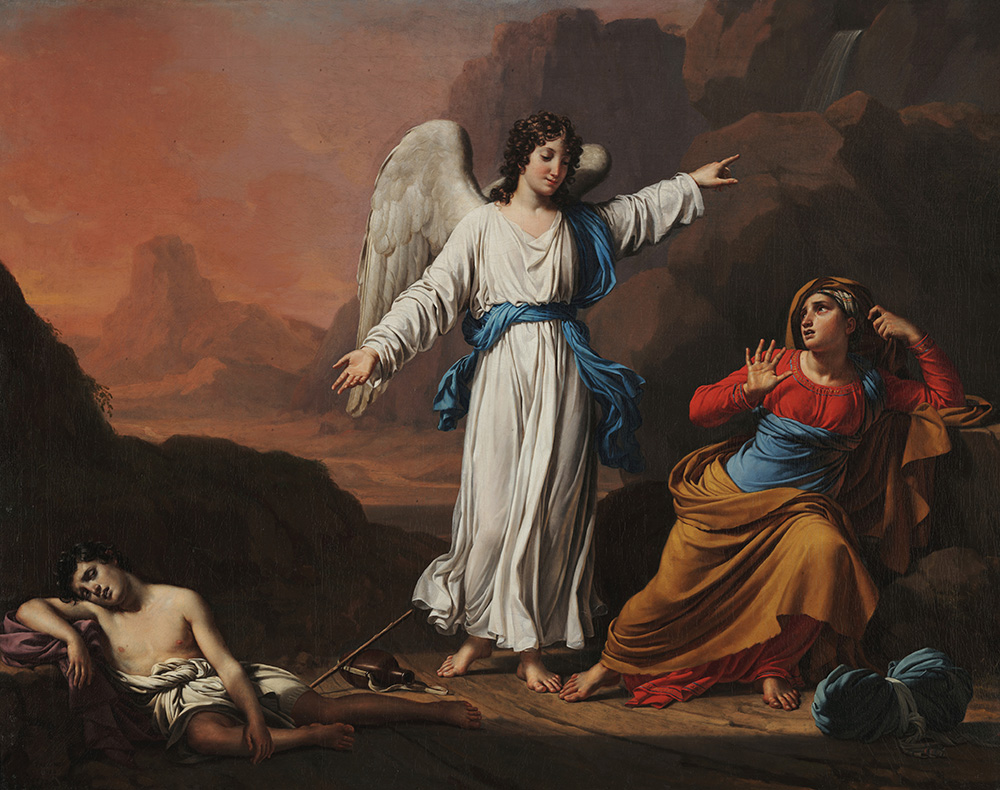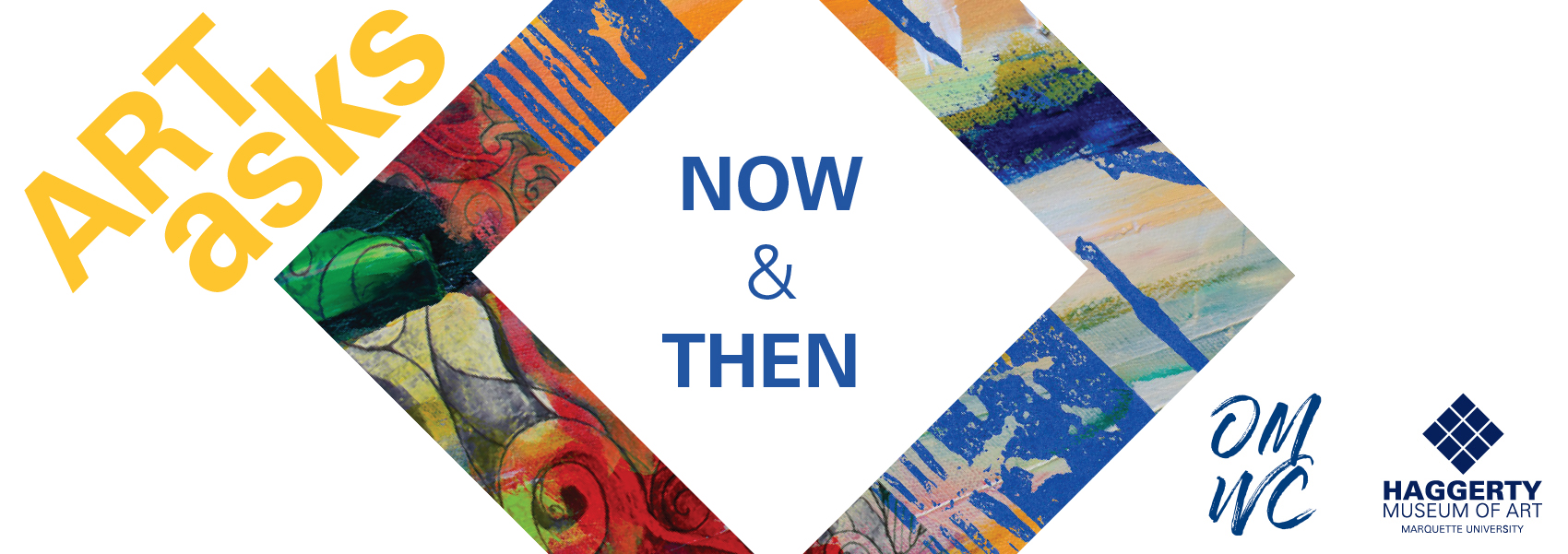 Luis González Palma (Guatemalan, b. 1957) El Santo Sudario, 1989
Luis González Palma (Guatemalan, b. 1957) El Santo Sudario, 1989
 Joseph Paelinck (Belgian, 1781-1839), Hagar and Ishmael in the Wilderness, 1822.
Joseph Paelinck (Belgian, 1781-1839), Hagar and Ishmael in the Wilderness, 1822.
This month’s images include a photograph and an oil painting: El Santo Sudario by Luis González Palma and Hagar and Ishmael in the Wilderness by Joseph Paelinck. The former was taken in 1989; the latter was painted more than a century earlier in 1822. Both works are part of the exhibition Double Vision: Art from Jesuit University Collections. This watershed exhibition vividly portrays the unique role of art in Jesuit teaching, where it provides boundless ways of finding meaning in life by combining and recombining ideas and information with imagination, feelings, and reflection.
Akin to the Stations of the Cross, Double Vision has fourteen topoi or themes, which name fundamental aspects of human being: justice, courage, strength, devotion, solidarity, mercy, perseverance, discernment, wisdom, honesty, acceptance, sacrifice, compassion, and hope. Two works have been carefully matched with each theme, modeling some of the diverse ways our humanity is made manifest. Each pair also opens a visual conversation that in-person and online visitors to the Haggerty are invited to join. The November selections for Art Asks represent mercy. Individually and together, they ask us to confront acts of “othering” which set people apart unequally based on their differences. Although El Santo Sudario and Hagar and Ishmael in the Wilderness were created in very different times and places, when viewed today they offer timely reminders to confront the inequalities that persist in human society.
Art Asks: Now & Then
Post and tag your writing with #ArtAsks #HMA #OttWC
Prompt 1 (5-15 minutes)
Luis González Palma is one of Latin America’s most significant contemporary photographers. Frequently his subjects are Guatemala’s indigenous Maya, who have endured centuries of violence and indignity, but who fiercely preserve and promote their cultural heritage. It is common in Guatemalan society for indigenous people to cast their eyes down in the presence of someone of a higher social class. But González Palma’s subjects assert their dignity with their intense gaze (la mirada).
El Santo Sudario is a photo emulsion of a Mayan face on linen. Although the title phrase translates literally into English as “the holy shroud,” santo sudario can refer to Veronica’s veil (which miraculously retained an image of Christ’s face when she wiped the blood and sweat from it on the road to the Cross) or to the cloth used to clean and cover Jesus’s head after the Crucifixion. In this representation, a wizened Mayan elder bears a thorny crown. As one viewer, a student at Washington University in St. Louis, describes: “The face is tired, world-weary and understanding—a direct reference to Christ at the end of his life. Palma, born and raised in Guatemala City, Guatemala, makes this explicit reference to draw attention to our uncomfortable history with pre-European American civilizations. The Mayan wears a crown of thorns, furthering the comparison of a Mayan Christ-like figure. Except, in this case, instead of one standing in for humanity’s sins, their entire civilization was decimated.”
- Set a timer for 2 minutes and look closely at the image. Do the folds of the fabric impact the way you perceive the image? What else do you notice? Are your eyes drawn to the center of the composition or elsewhere?
- Set a timer for another 5 minutes and write what you think the Mayan might say if he were to start speaking to us today.
- Set a timer for 5 more minutes and write back to the Palma’s Mayan, imagining yourself in direct dialogue with him.
Prompt 2 (5-15 minutes)
In the 21st chapter of Genesis, Abraham’s obeys his wife Sarah and sends his enslaved concubine Hagar into the desert with their infant son Ishmael. When Hagar runs out of water, she and Ishmael collapse, weeping. An angel appears and leads Hagar to a well, explaining: “God has heard the boy crying as he lies there. Lift the boy up and take him by the hand, for I will make him into a great nation.” In the Quran’s account of Hagar and Ishmael’s story, the well is located at Mecca, and modern-day Muslims recall Hagar’s quest for water during the Hajj pilgrimage, which takes place next in July, 2022.
- Set a timer for 2 minutes and look closely at the faces of each figure. Follow their gazes and reflect on how their expressions direct your eye to different portions of the composition. Do the same exercise but focus on the limbs on the figures instead.
- Set a timer for another 5 minutes and write the scene that Paelinck has painted from a single point of viewpoint, choosing Ishmael, the angel, Hagar, or the wilderness.
- Set a timer for 5 more minutes and reflect on what you wrote. What details did you include in conjunction with the perspective you chose to represent? What details did you leave out? If you do this prompt with friends or classmates, compare what you wrote and the choices you made.
Prompt 3 (5-15 minutes)
This month, El Santo Sudario and Hagar and Ishmael in the Wilderness appear side by side to illustrate the concept of mercy. If we look up “mercy” in Urban Dictionary, we learn that "Mercy is a girl who shows empathy and she interacts well with others.” Merriam-Webster defines mercy as “compassionate treatment of those in distress,” while Jesuit theologian James Keenan defines mercy as “the willingness to enter into the chaos of another.”
Often, acts of mercy involve power differences, and someone with power or in power shows compassion to someone who, at least in the moment, has less. But mercy also implies a recognition of another person’s essential dignity and humanity. By the same token, behaving mercifully may require us to change our minds and re-envision the world around us. It might also demand we see one another and ourselves differently.
- Spend at least five minutes with one of this month’s two images and meditate on the qualities of mercy it presents. If you were to define mercy by the use of light and color in the work you chose, how would you describe it? If you were to elaborate, taking into account line and form, what would you add? How does the medium of the work you chose and the way it is framed add to your definition? Take informal notes to keep track of your thinking.
- Spend at least five minutes with the other artwork, answering the questions above. Take informal notes to keep track of your thinking.
- Spend at least five minutes comparing the definitions of mercy elicited by Palma’s and Paelinck’s works. How do the similarities and differences help you formulate a robust idea of mercy, including the challenges and rewards of its practice?
Prompt 4 (10-15 minutes)
With Double Vision, the Haggerty Museum of Art contributes to the ongoing Ignatian Year observance. Begun in May of 2021, the Ignatian Year honors the 500th anniversary of “the cannonball moment,” when Ignatius the soldier was injured in the Battle of Pamplona, prompting the change of heart that led him to transform his life—and to become a model of transformation and grace for others. At Marquette:
The Ignatian Year is an opportunity for our community to look back in gratitude for all that has transpired in the last 500 years. Just as well, we look forward in hope, recognizing the privilege of being a part of something greater than ourselves and uniting in the rich traditions and origins of a Jesuit education, all for the greater glory of God, Ad majorem Dei gloriam.
For this set of exercises, which follows the flow of the Daily Examen or Jesuit prayers of reflection, select one of this month’s two images and do the following over 10-15 minutes:
- Look closely at the work you chose without looking away and become aware of its presence.
- Shift your thinking from awareness to appreciation, and think about what you like about the work you have chosen as well as what makes it “good” from your point of view.
- Shift your attention again, and notice what you feel, whether it is a single emotion or a range. Take some time to just feel and also reflect on what you are feeling.
- Choose one element of the work you have been looking at and one emotion it raises, and focus your attention on it. Be fully present. let yourself experience the work and your feelings as fully as possible.
- Before you look away, turn your thoughts to the future, whether the next 10 minutes, the next few hours, or the next few days. Will you carry anything from these last moments with you? Will you deliberately leave anything behind so you can move ahead more freely and easily?
Prompt 5 (5-10 minutes)
Both of this month’s artworks are rife with stories. They not only contain an abundance of stories within them, crisscrossing the times and places each was made and has since circulated. Palma’s and Paelinck’s works also invite us to tell our own stories. Like good listeners, they spark us to reconnect to the world around us, whether we make direct or indirect, even random associations; whether we recall past incidents in our own lives or imagine new possibilities of realities.
- Imagine you were in a conversation with one of this month’s two works. Imagine that either El Santo Sudario by Luis González Palma or Hagar and Ishmael in the Wilderness by Joseph Paelinck had been talking for the last 5 or 10 minutes, telling you a story. Now imagine they wrapped up their narrative and said to you, “It’s your turn.” What story would you tell in response? Would you talk about something in particular that happened to you or someone you know? Or does the work you chose make you want to invent a story? Whatever the case, write the story you want to tell for 5 or 10 minutes.
- When you are finished, feel welcome to share what you have written with the Haggerty and the Ott via email.




